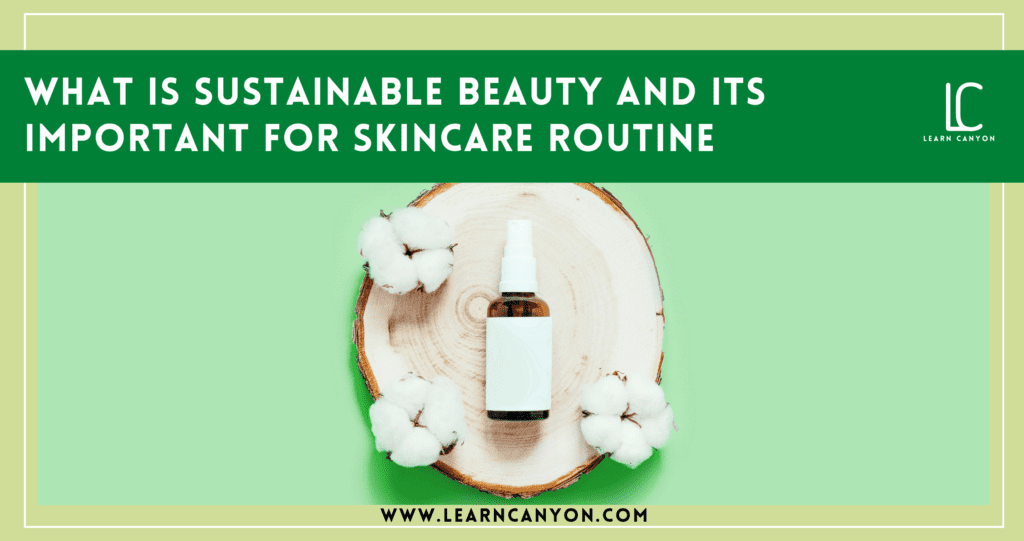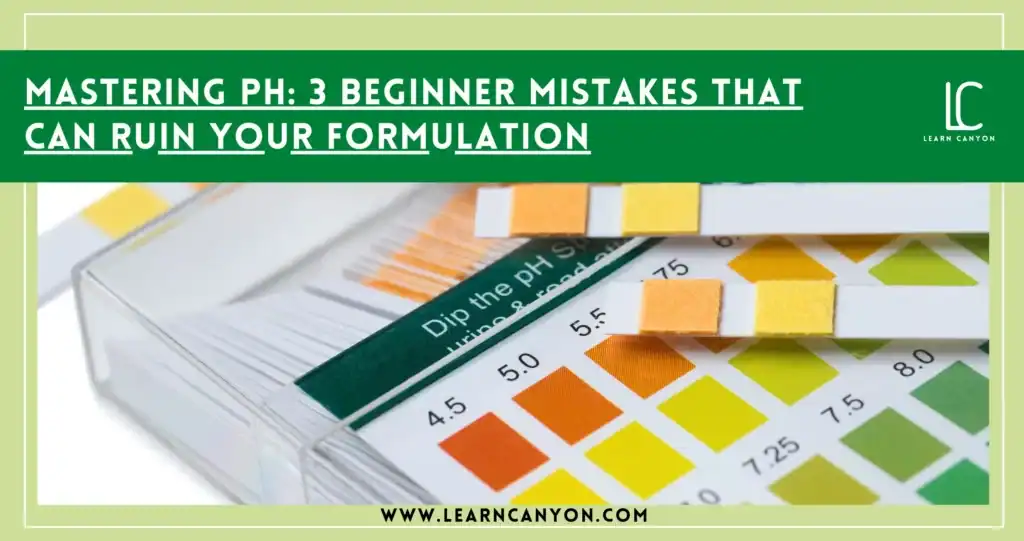More than ever before, consumers are more interested & curious about your process rather than your product.
As public awareness of environmental issues grows, many cosmetic companies are looking for more natural and environmentally friendly emulsifiers and components for their products.
The skincare industries have a well-known detrimental environmental impact.
They pollute the environment and deplete natural resources in a variety of ways. They also have a dubious history of unethical business activities and human rights violations.
Consumers, unwittingly, appear to be exacerbating the problem by increasing demand.
Manufacturing firms seeking to enter the green market must understand the nuances of the sustainability movement, including the advantages of going green and the market’s capacity. But how much truth is out there in those green beauty markets?
If a company claims to be ethical or sustainable, is it merely marketing and/or greenwashing or implementing what they preach?
It’s critical to know what you’re looking for. A lot of things can influence whether or not a company or product is truly ethical and sustainable.
Here are some of the top things to know about sustainable beauty before cultivating organic skincare standards.
First things, first.
What is Sustainable Beauty?
Typically, sustainable beauty refers to cultivating certain environmentally friendly beauty standards where organic formulations, manufacturing methods, or packaging is done to develop eco-friendly beauty products.
In the cosmetics industry, “green” or “sustainable” cosmetics are defined as products made with natural components and renewable raw materials.
Petrochemical components generated from petrol, a nonrenewable and economically volatile fuel, are used by many businesses.
When a consumer sees the words “organic/sustainable/green cosmetics,” they instinctively assume the product or brand is environmentally conscious.
Read the in-depth article on How To Start Your Cosmetic Line: Your Ultimate Guide

However, clarification is still required in the realm of green cosmetics.
The Federal Trade Commission (FTC) in the United States has issued guidelines to clarify what sustainable or natural implies in marketing terms, however, they are still vague.
Do you know what the experts say;
“There is no actual, objective, quantitative measurement of sustainability that is truly standardised or globally accepted,” says Neil Burns, CEO of P2 Science, a manufacturer of renewable speciality chemicals.
“People are working on it, but we aren’t there yet.” Stephen Nilsen, a senior perfumer at Givaudan tastes and fragrances, adds, “People are striving to come up with their company definition of sustainability what it means to be human. Supporting communities who make materials, having a sustainable source of a beginning material, environmental protection, and excellent water stewardship are all examples.”
Why “sustainable beauty” is important
There is always a hunger for knowing the reasons behind anything that is factually not clear to people.
So here, let us try to understand its importance before considering to whether buy and produce sustainable cosmetics or not.
The benefits of sustainable cosmetics exceed the additional expenditures and research for the average consumer.
Certain sustainable cosmetic brands think about how their products will be recycled or repurposed at the end of their lives. They urge customers to finish their current purchases before purchasing new ones, and they limit the number of products they issue each year.
Environmental responsibility, better efficacy, and long-term health are three primary benefits of organic cosmetics.
1. Environmental Responsibility
Modern customers are becoming more aware of global issues and are concerned about social and environmental issues.
Sustainable products have a lower environmental impact, which is one of their key advantages.
Every week, new news emerges regarding harmful carbon emissions or oceanic plastic floats.
Many of the petrochemicals used in traditional cosmetics are harmful pollutants that harm both the environment and our bodies.
Consumers are demanding natural, low-polluting items as we become more eco-conscious.
The ban on microbeads is a recent example of pollution and consumer demand. Many shower scrubs and exfoliating products contain microbeads, which are microscopic bits of plastic.
Research says they do not disintegrate, however, and according to an investigation in 2015, over eight trillion microbeads are washed into our rivers every day.
Later that year, President Barack Obama signed a bill prohibiting the use of tiny plastics, demonstrating that environmental stewardship is becoming more important to the country and its citizens.
That’s why many sustainable skincare brands are morally responsible.
Their eco-friendly cosmetic products are biodegradable and do not wind up in rivers, posing any damage to marine life.
To safeguard animal welfare throughout the supply chain, they only utilise certified cruelty-free and organic ingredients.
2. Increased Productivity
Skin irritation and allergic responses are less likely to occur with natural and oleochemical substances.
Sustainable products focus on natural therapeutic properties found in plants and animals – elements humans have been utilising for ages — rather than manufactured, poisonous chemicals or artificial colours.
Consider glycerine, a naturally occurring palm oil product. Soaps, medications, and cosmetics contain transparent, non-toxic liquid.
Glycerine is a great moisturiser since it is a humectant. Glycerine improves the body’s hygroscopic properties, allowing the skin to absorb and retain water. It can be used anywhere on the body due to its non-irritating nature. It’s a powerful anti-ageing substance that can also be used to treat acne because of its anti-microbial characteristics.
Thus, Glycerine is one of the perfect examples of the natural effectiveness of sustainable beauty products.
3. Long-Term Wellness
While petrochemicals may produce immediate results, their long-term impacts on persons and the environment can be extremely harmful.
Headaches, eye damage, acne, hormone imbalance, and premature ageing have all been linked to the use of synthetic cosmetics over time.
Phthalates have even been related to type 2 diabetes and cancer.
A consumer who opts for sustainable cosmetics avoids the stress and uncertainty that comes with hazardous, synthetic goods and invests in their long-term health and beauty.
In addition to those above reasons, let us try to know why one should produce sustainable cosmetics;
Environmentally friendly items don’t have to be low-quality or low-profit. Small actions toward sustainability can considerably improve public opinion and raise sales, especially as the public’s focus on business ethics grows.

4. Higher-Quality Goods
Cosmetics of high grade deliver beneficial outcomes while posing no risk to the user.
Many petrochemical compounds, such as mineral oil, however, have a low toxicity level for users. Such items have been demonstrated to be allergens and, according to some research, may cause cancer when aerosolized and inhaled.
The toxicity of most bio-based goods is minimised, resulting in safer, high-quality products. And one can adopt a healthy lifestyle.
5. Enhances Corporate Social Responsibility
Cosmetics makers have a unique chance to focus on corporate responsibility with sustainable cosmetics.
Aside from the beneficial effects of green marketing on a company’s image, taking further measures of sustainable sourcing or packaging can have a big influence.
When a business expands its sustainability activities, it assumes responsibility for its impact on global health and the economy.
A company gets power and respect from customers, suppliers, and other parts of the distribution chain when it takes corporate responsibility for its manufacturing.
6. Refines Brand Reputation
Sustainable products send a statement to customers that this company values quality, safety, and sustainability, and is deserving of their trust.
Consumers are looking for companies that embrace transparency and honesty as their concerns about synthetic items rise.
You demonstrate your global and social awareness by switching to sustainable, green products. This encourages customer loyalty to a brand rather than just to specific products. People will start buying a company’s items if they agree with its aim.
Want to know the 8 Secret Antioxidants To Look Younger!! read the article
How sustainable cosmetics are made
Cosmetic manufacturers all over the world are seeking oleochemicals, as well as many other potential sources for them. Common sources include the following:
Agricultural Plants
Oils and alcohol are made from soybeans, corn, and other agricultural plants in the cosmetic sector.
These plants are used to make green cosmetic emulsifiers, surfactants, and biocatalysts, which may be obtained inexpensively and sustainably.
Bacteria
The Deinococcus bacteria, which Deinove in France is studying for its chemical manufacturing properties, is one example of a renewable resource now under research.
Deinove has developed aromatic compounds and pigments for the cosmetics sector, with a market worth in the hundreds of millions of dollars.
Natural Oils
Fatty alcohols, which are utilised as chemical surfactants, are commonly derived from palm and coconut oils.
Argan oil and avocado oil are two more oils to consider. A typical byproduct is a glycerine, a palm oil derivative.
At a processing factory, the raw materials are separated into oleochemicals. Hydrolysis (using water) or alcoholysis (using alcohol) are used to separate the fats or oils.
Ingredients that are not sustainable
1. Coal tar dyes
Coal tar dyes are labelled as p-phenylenediamine or hues with the abbreviation “CI” and a five-digit number.
These colours are petrochemical combinations that have been related to human cancer.
2. Aluminium
Aluminium, which is commonly found in antiperspirants, enters the body through the underarm tissue and prevents sweat ducts from functioning properly.
It has been related to breast cancer, Alzheimer’s disease, and osteoporosis, among other diseases.
3. BHT & BHA
Synthetic antioxidants like BHA and BHT are commonly found in lipsticks and moisturising creams as preservatives.
BHA and BHT are known to affect the endocrine system, according to the European Commission.
4. Dibutyl phthalate (DBP)
DBP is a dye solvent that’s commonly found in nail products. It is hazardous to human reproduction and helps other substances produce genetic alterations.
5. Formaldehyde-releasing preservatives
These preservatives can be found in a variety of cosmetics and cleaning goods, including toilet bowl cleaners.
Formaldehyde-releasing preservatives, as their names imply, constantly release small amounts of formaldehyde, a recognised human carcinogen.
6. The (Occasional) Issue With Natural
There is this hard truth that “natural” ingredients are not always sustainable.
We’ve been told that natural and organic ingredients are better for us and the environment since the beginning of the eco-friendly beauty movement.
But, as we learn more about the environmental impact of our aesthetic choices, we’re seeing that this isn’t always the case. In reality, lab-created products are sometimes the most environmentally friendly.
Nature, as amazing as it is, has a finite quantity of resources to provide us in terms of beauty ingredients—they aren’t sustainable, especially when vast quantities of plants are required to manufacture a product on a massive scale.
Fragranced items are a good example of this problem.
“Consider all the fragrant washing detergent,” Nilsen (a beauty expert) continues.
“There isn’t enough land on the planet to cultivate enough perfume to scent all of the laundry detergents that people use across the world if we wanted to create that perfume using natural aromas.
As a result, we must consider synthetic alternatives to save natural resources for more important things, such as food.”
Another expert Lorna Sommerville, the brand’s CMO says,
“When you compare everything involved in collecting those raw ingredients versus the ability to make something like that synthetically, We’re continually balancing the advantages and disadvantages of what we know our clients want and finding the correct trade-offs and balance.”
“Palm oil is completely natural, safe, and potentially sustainable, but it is rarely so because it is grown on plantations where rainforests have been cleared,” says Mia Davis, Director of Mission at clean beauty shop Credo.
Also, she continues by saying, “Thousands upon thousands of species have been relocated as a result of this activity. They establish rows and rows of palm trees, then harvest the resource and burn it all down again.
The environment takes a long time to recover if it can recover at all. Palm oil and its derivatives are thus safe and natural, but they are not always sustainable.”

Another natural element that isn’t so great? Animal by-products, such as ambergris, which comes from whales and whose sourcing resulted in the slaughter of countless thousands of these noble creatures in the past.
However, thanks to experts like those at Givaudan, formulators now have synthetic substitutes derived from plants that provide the same characteristics without harming wildlife.
So, scientists have been working on certain lab-made measures to solve pressing sustainability issues in beauty.
Here are a few examples of recent scientific breakthroughs that have resulted in eco-friendly solutions:
Scarcity of Resource
As Nilsen pointed out, there is only so much area that can be used to cultivate plants, so many of the components that are beneficial to our beauty routines are impossible to farm on a large scale.
For example, If we tried to utilise vanilla beans for everything that tasted or smelled like vanilla, it would be disastrous for the environment.
Artificial vanilla substitutes, like vanillin, were developed in the nineteenth century to satisfy our insatiable desire for vanilla in everything.
Likewise, in this modern dayside, While there are synthetic and plant-based alternatives, Givaudan took a step further last year by developing ambergris manufactured from sugarcane, a very renewable resource.
Givaudan’s version, Ambrofix, employs sugarcane fermentation to recreate the warm, enticing aroma of ambergris.
“By knowing enzymes, fermentation, and biotransformation, we can now synthesise this extraordinarily complex molecule,” Nilsen explains. “We need 100 times less land to make it, and we use a 100 per cent renewable resource as the beginning material for making this molecule”.
Deforestation of Palm Oil
As we’ve become more conscious of the environmental damage that industrial palm growing is causing in places like Malaysia and Indonesia, ethically obtained palm oil is progressively becoming a focus for many businesses.
Therefore, this company named C16 Biosciences, based in New England is employing brewing to provide a palm-free alternative to palm oil.
Davis, an expert formulator, explains, “It resembles palm oil and palm oil derivatives in a way that would be fundamentally sustainable, highly safe, and very controllable.”
Wastage of Ingredients
While the cosmetics industry loves to brag about all of the natural and organic components it employs, whole-plant formulation—that is, employing the complete plant in a product—remains a niche practice.
Companies typically use a portion of the plant, such as the root, seed, or fruit, in their formulae and discard the rest.
Few scientists investigated many ways to upcycle trash into desirable ingredients.
Again as the expert, Nilsen said,
“We take the pulp waste from juice extraction and refine it to make apple oil—one it’s of its first fruit oils with a distinct scent component.”
The upcycling doesn’t stop there: after the oil is extracted, the trash from the extraction process is transferred to be used as cattle feed.
This is how sustainability issues can be solved effectively.
Guide to sustainable beauty & making better beauty choices
If we want to avoid the environmental disasters of the past, we must practise sustainability in all forms.
However, as our experts pointed out, it’s not always easy to tell whether a company is employing sustainable practices just by looking at its label.
So, how can you ensure that you are being responsible? Unfortunately, it isn’t a foolproof strategy because it typically necessitates corporations being honest about how their products are produced and manufactured, which isn’t currently required or regulated.
Asking hard questions about the companies and stores you buy from is the finest thing you can do right now.
People need more honesty and transparency on ingredients that are all grown & harvested in the lab.
Proper education, attention, in the area of organic or sustainable beauty is a necessity for all consumers.
Many want to follow up with eco-friendly skincare but doesn’t know where to start.
Here is the guide to starting sustainable beauty;
Proper Use & Disposal
To switch to a sustainable beauty routine, It is not necessary to buy a whole new skincare regime, instead, use the ones you already have.
Recycle or repurpose the packaging once you’ve finished with your skincare goods.
Larger cosmetic pots can be washed and reused as plant pots, DIY candle holders, or homemade organisers.
Do your research
Investigate skincare companies thoroughly to ensure that they are company sustainable and ethical.
The following are some of the most important areas of research to look into:
- Ethics & Values: Are they concerned about the health of their customers’ skin, the environment, and ethical ingredient sourcing?
What motivates them to do what they do?
- Animal welfare: Are they cruelty-free and vegan-certified? Is it true that the ingredients they employ have not been tested on animals?
- Marketing campaigns: What is the message that they employ to promote their products? Is it believable? Does it appear to be a case of greenwashing?
- Accreditations: Are they accredited by any associations? Are they verified by any proper regulatory bodies?
- Transparency: Is it clear where their ingredients come from and how they treat their employees?
- Product Range: How many new goods do they introduce each year? Is it a lot, and are they only interested in selling you the latest products in the line?
- Purchase with a minimalist skincare routine in mind, Sustainable skincare is all about using a few high-quality products that last a long time, rather than getting overwhelmed and overbuying. This method is beneficial to the environment, your skin, and your money.
- Repeating step one Unless they aren’t working for you, resist the urge to toss out half-used skincare products in favour of gleaming new ones. Repeat the previous steps until you’ve perfected your ultimate sustainable skincare routine.
Note (Recent stats): 5 recent developments in sustainable beauty across the Asia Pacific

Manufacturers who switch to sustainable cosmetics manufacture have a bright future ahead of them.
The increased popularity of environmentally friendly cosmetics has had a huge impact on the cosmetics industry.
The sustainable cosmetics market has grown at a 15% annual pace, thanks to a growing number of customers and merchants wanting cosmetics made with natural or sustainable ingredients.
This rate of expansion much exceeds that of the worldwide personal care and cosmetics business, which is now growing at a rate of 5% per year.
Organic beauty will be worth $48.08 billion by 2025.
Freqently Asked Questions:
Which Ingredients Are Safe & Effective?
Fatty acids, Castor oils, Coconut oils, Phenoxyethanol are safe and effective.
Is Sustainable beauty safe?
There are numerous beauty-related terms, some of which overlap and others with gaps. Due to the lack of regulation, these phrases can signify almost anything.
A brand might claim they are ethical & sustainable but you need to know whether it’s about greenwashing or is that what they preach! It’s critical to know exactly what you’re looking for.
A variety of elements might influence whether or not a company or product is truly ethical and sustainable.
What are sustainable practices?
– Brands that allow you to reuse your existing packaging or utilise compostable packaging do exceptionally well in the packaging department.
– One of the most essential characteristics of a sustainable and ethical company is a brand that is dedicated to ethical ingredient procurement.
– Brands that are truly concerned about their environmental effect go to considerable efforts to ensure that they have excellent waste and resource management practices in place.
– Charitable giving gains the attention of consumers too where many ethical firms have a dedicated giving policy, which is inspirational.
What are oleochemicals?
A chemical substance made from animal or vegetable oils or fats for industrial use.
Conclusion
Sustainable beauty is a lengthy process and does take time. People need to understand that such beauty standards have both pros and cons as mentioned in the above points with examples.
To put it another way, if you truly want to adopt a more environmentally friendly beauty routine, do your research and keep in mind that the best option for the environment may not always be one that originates from nature, but rather one that is made or refined by scientists in a lab.
Check everything that you need to know weighing what is best suitable for your skin, with the obvious practice of sustainable beauty.
So, you don’t have to jump right in and start running. A million people buying one fewer skin care product has a significantly greater impact than a thousand people going zero waste.
Our Courses
If you are wondering where to start your cosmetic formulation journey, you have landed in the right place, where you can become an expert cosmetic formulator and start your cosmetic business with our certification courses.
Our courses included step-by-step procedures to understand formulation techniques to learn to implement and create cosmetics from scratch quickly. To get started you can go through our courses and certification programs here.












1 thought on “What is Sustainable Beauty & it’s important for Skincare Routine”
Well written and informed. Learnt alot from this, thanks. Looking forward to read more.